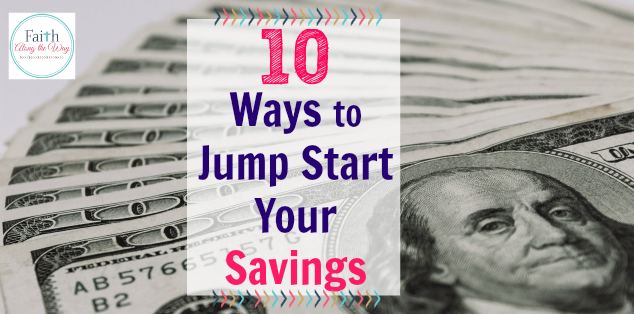10 Ways to Jump Start Your Savings
Is saving more money in the new year on your list of goals? Maybe you’ve never done much with it, basically because you weren’t really sure where to start, which means that you are in exactly the right place! Or, you could be on the other end of the spectrum and have been saving money for some time now, but you are looking for some new ideas to really kick things into high gear. If this is you, then you are in luck as well!
Wherever you fall on the savings spectrum, here are 10 ways that you can jump start your savings today and with the whole year ahead of you, your savings will really grow!

Create a budget
Your budget can be simple or complex, but a budget is really broken down into nothing other than making a simple accounting of what comes in and goes out in your family pocketbook. Creating an accurate budget takes time as you account for things over a few months, but simply using a notebook to record everything will suffice.
Create a meal plan
A meal plan can be done once a week, once a month, or for any amount of time in-between. The benefit of a meal plan is being able to shop smart for the things you need rather than buy on impulse in the store. Ideally, your meal plan would start by doing a quick inventory of the food you have on hand. This way you can avoid having to throw out spoiled food. In creating a meal plan that starts with an inventory and takes into account the items that are on sale, your savings can really add up over the month. A meal plan is an essential tool in keeping my grocery budget at $250 a month for my family.
Establish a “waiting period”
A waiting period is a predetermined amount of time that is required between finding something you want to buy and actually buying it. So often we fall victim to buying things on impulse. We generally have a three-sleep waiting period required in our house. It is amazing how many things I decide NOT to buy after sleeping on it for three days.
Give everyone an allowance
It you are looking to save money, allowances aren’t just for kids as they are an effective tool in keeping adults from overspending as well. While no one really loves having an allowance, myself included, most people do like the savings that not overspending brings in.

Don’t pay interest
If you are paying interests on anything other than a mortgage, beginning to payoff those cards or loans that are creating interest will make a huge difference! Interest is like a hidden cancer that just keeps growing and growing, often unnoticed.
Check your receipts
You would not believe how often we overpay for things that we never notice. Things ring up wrong, discounts are never applied, and sometimes things are just scanned more than once. Whether groceries, clothing and household items, or things like prescriptions, consumers lose an astronomical amount of money collectively each year by mistake. In a year’s time, you will find errors as long as you are looking for them.
Check your credit card and bank statements
I check mine every couple of days, in fact. Have you ever had someone use your credit or debit card fraudulently? This has happened to me more than once, and luckily I have caught it in a timely way each time. Sometimes the charges are small, but once there was a fraudulent charge for $140! Going over your credit card statements and your bank statements with a watchful eye could save you a ton of money. Ideally you won’t find anything, but if you do, it could save you a bunch!
Choose a couple of things to cut
These don’t have to be big sacrifices, but the thing about making small sacrifices is that they add up to big savings over time. It might be a coffee out once a week, it could be downgrading your cable plan, or it could be cooking dinner in your home all week rather than grabbing something here and there. However you do it, find two or three things to cut from your normal spending habits.
Pay yourself with every paycheck
Just like you tithe, just like you pay your bills, and just like you pay taxes, pay yourself with every paycheck. It doesn’t have to be much, but paying yourself with every paycheck means that you’re building up some savings. Decide on an amount to save, put it in writing, and make a commitment to paying yourself that amount with every paycheck. Then, put it in a savings account.
If you don’t have the money to pay for it, don’t buy it
This may seem basic, and this may seem harsh, but if you are looking to get a jump start on your savings, this is how to do it in a big way. Of course the unexpected comes up. For instance, if your dryer breaks and needs to be repaired this is something that may need to be addressed before you actually have money to pay for it. However, as a general rule of thumb, only buying what you can pay for will generate some nice savings over time.
Really tucking away some money to save is a common desire but not one that is always easy. Sometimes it is just a matter of having a few different things to try. Try any of these 10 ideas to make this a great year for savings!

These are some great ideas.I especially like the idea of giving everyone- not just kids- an allowance.
It can be so easy just to spend, but I’m with you, and think an allowance would totally help!